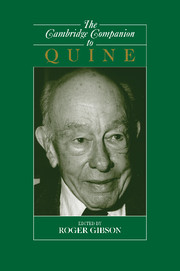Book contents
- Frontmatter
- Willard Van Orman Quine
- 1 Aspects of Quine’s Naturalized Epistemology
- 2 Quine on the Intelligibility and Relevance of Analyticity
- 3 Quine’s Meaning Holisms
- 4 Underdetermination of Physical Theory
- 5 Quine on Reference and Ontology
- 6 Indeterminacy of Translation
- 7 Quine’s Behaviorism cum Empiricism
- 8 Quine on Modality
- 9 Quine and Logical Positivism
- 10 Quine and Logic
- 11 Quine on Quine
- Selected Bibliography
- Index
10 - Quine and Logic
Published online by Cambridge University Press: 28 May 2006
- Frontmatter
- Willard Van Orman Quine
- 1 Aspects of Quine’s Naturalized Epistemology
- 2 Quine on the Intelligibility and Relevance of Analyticity
- 3 Quine’s Meaning Holisms
- 4 Underdetermination of Physical Theory
- 5 Quine on Reference and Ontology
- 6 Indeterminacy of Translation
- 7 Quine’s Behaviorism cum Empiricism
- 8 Quine on Modality
- 9 Quine and Logical Positivism
- 10 Quine and Logic
- 11 Quine on Quine
- Selected Bibliography
- Index
Summary
No one since Russell has contributed so much to both philosophy and logic as Quine. No major philosopher has given anything like so much to logic, nor has any important figure in logic borne Quine’s stature as a philosopher. His work in the two fields, though distinguishable, has been very much related. He has been a pioneer philosopher of mathematical logic, while he has integrated his view of logic into the very core of his epistemology. I will discuss how logic fits with the rest of Quine’s philosophy and what motivated his choices as an expositor and teacher of logic. I will examine in particular aspects of his text Methods of Logic, now in its fourth edition.
Logic plays a central role in Quine’s philosophy. Quine is preeminently an epistemologist. His epistemology is wedded in interlocking ways to empiricism, naturalism, and physicalism; together they lead him to see science not only as the arbiter of what is to be believed about the world but also as providing the context in which we must make our philosophy. Rather than pursue some first philosophy, we look to science for our bearings: “[I[t is within science … that reality is to be identified and described” (TPT 21). And “the basic structure of the language of science … is the predicate calculus: the logic of quantification and truth-functions” (FM 160).
- Type
- Chapter
- Information
- The Cambridge Companion to Quine , pp. 270 - 286Publisher: Cambridge University PressPrint publication year: 2004



